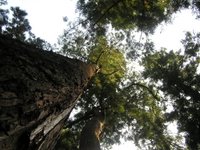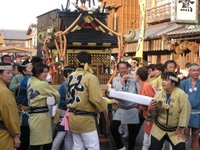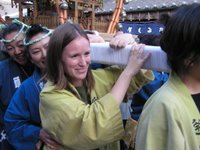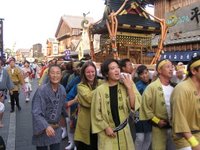Ise-jingu
Ahh. Another good day.
Went to Ise-jingu (Ise shrine) in Mie Prefecture with Jo yesterday. After a rough start, including jumping off the right train at the last minute due to confusion over price, we finally got started on our way around 11am. And it was a great day for a trip: mostly sunny, around 70 degrees, and dry.
 Ise-jingu is amazing for many reasons; one, it's Japan's most holy Shinto shrine, housing the "sacred mirror of the emperor"; which hasn't been viewed in 1700 years. According to Lonely Planet's Japan guide, "since being enshrined here in the 3rd century, this mirror has not been seen by human eyes. Members of the Imperial family technically have the right to see it, but apparently none of them have ever tried to exercise this right. It stands on a wooden pedistal wrapped in a brocade bag. As each bag wears thin, the bag with the mirror inside is simply placed inside another bag. This ensures that the mirror is never sullied by the gaze of a human and has resulted in what one writer has suggested must be the world's best collection of Japanese brocade weaving." Cool.
Ise-jingu is amazing for many reasons; one, it's Japan's most holy Shinto shrine, housing the "sacred mirror of the emperor"; which hasn't been viewed in 1700 years. According to Lonely Planet's Japan guide, "since being enshrined here in the 3rd century, this mirror has not been seen by human eyes. Members of the Imperial family technically have the right to see it, but apparently none of them have ever tried to exercise this right. It stands on a wooden pedistal wrapped in a brocade bag. As each bag wears thin, the bag with the mirror inside is simply placed inside another bag. This ensures that the mirror is never sullied by the gaze of a human and has resulted in what one writer has suggested must be the world's best collection of Japanese brocade weaving." Cool.Another cool thing about O-Ise-san (as it's "affectionately" called) is the shrine's impermanence. Jingu is torn down every twenty years, only to be rebuilt alongside the original site - as it has been for the last 1700 years, making it one of the best - if not the best - example of pre-Buddhist architecture in Japan. Depending on who you believe, it's rebuilt - down to the last peg - either to keep the carpentry skills alive, or because Shinto tradition holds that when the Emperor dies, his possessions (and hence, his shrines) are defiled, and each new Emperor needs clean new shrines, a tradition which has become embedded in shrine-building. Ise was last rebuilt in 1993 at a cost of over 5 billion yen.
 And so we went to Ise and walked through the grounds, through trees that are as big around as cars, through buildings that are the same as those built 1000 years before Europeans discovered America. And what a perfect autumnal day for it! The sun fell down through trees older than systems of government, and priests walked along trails groomed in the same way they'd been for millennia.
And so we went to Ise and walked through the grounds, through trees that are as big around as cars, through buildings that are the same as those built 1000 years before Europeans discovered America. And what a perfect autumnal day for it! The sun fell down through trees older than systems of government, and priests walked along trails groomed in the same way they'd been for millennia. Jo really wanted to take pictures of the amazing scenery, but I thought that might not be such a good idea: every report I'd read said that Ise is sacred, and there's no photography anywhere on the grounds. Apparently I was wrong though; literally dozens of people were walking around with cameras big enough to hold sake bottles. So, after asking some official-looking people whether or not it was okay to take photos, we started to snap away.
Jo really wanted to take pictures of the amazing scenery, but I thought that might not be such a good idea: every report I'd read said that Ise is sacred, and there's no photography anywhere on the grounds. Apparently I was wrong though; literally dozens of people were walking around with cameras big enough to hold sake bottles. So, after asking some official-looking people whether or not it was okay to take photos, we started to snap away.(Me [holding my camera]: Sumimasen, photo okay?
Official-looking security guard, while monitoring eight video cameras [laughing]: Hai, okay.)
One thing I wish I'd done, was ask for permission to photograph earlier in the day; we watched a procession of about 25 priests walk by - most in plain white robes, but some in beautifully bright colors - and I don't have any photos of it. Apparently it happens at least twice a day; priests deliver food to the main temple as an offering to Amaterasu Omikami, the sun goddess.
 After walking through the grounds for a few hours, we decided to check out the town outside. So we walked off the front bridge of the shrine grounds and just about right into a parade. Unbeknownst to us, there was a matsuri, a local festival, going on that day.
After walking through the grounds for a few hours, we decided to check out the town outside. So we walked off the front bridge of the shrine grounds and just about right into a parade. Unbeknownst to us, there was a matsuri, a local festival, going on that day.  I'm not sure exactly what festival it was, but WikiTravel suggests - along with many other interesting facts - that it might have been one of three days of the Kagurasai Ceremony.
I'm not sure exactly what festival it was, but WikiTravel suggests - along with many other interesting facts - that it might have been one of three days of the Kagurasai Ceremony.
 While we were watching the festivities, Jo was finagled into participating in the matsuri: a very nice woman saw us, came over and grabbed Jo (who hates to be the center of attention), gave Jo her coat, and pushed her into the line to help carry a mikoshi, a small poratable shrine, "that holds a god". But it was loud, and we were trying to understand a mix of Japanese and English, and some confusions arose.
While we were watching the festivities, Jo was finagled into participating in the matsuri: a very nice woman saw us, came over and grabbed Jo (who hates to be the center of attention), gave Jo her coat, and pushed her into the line to help carry a mikoshi, a small poratable shrine, "that holds a god". But it was loud, and we were trying to understand a mix of Japanese and English, and some confusions arose. "Oh," Jo said, "I thought you said it holds a goat!"
"Oh," Jo said, "I thought you said it holds a goat!"After the parade ended, we met some random towns-folk who very kindly served us some sake. They seemed thrilled to meet a Brit and an American in one go! Very nice folks; wanted to know what we thought of Japan, what we did, where we went, everything. Did I mention we got free sake?
Halfway between Jo's festival initiation and our final cups of sake with the our new friends, we stopped at a small stand on the side of the street for some local specialties: fried oysters on a stick and oyster croquets. Oh, so delicious; Ise, located on a peninsula in Mie, is "famous" (as everywhere in Japan is for something) for it's seafood.
After some food and some shopping, we decided to call it a day; we caught the train back to Nagoya, bought some french bread, cheese and olives, and watched some English-language TV. Good times.



0 Comments:
Post a Comment
<< Home